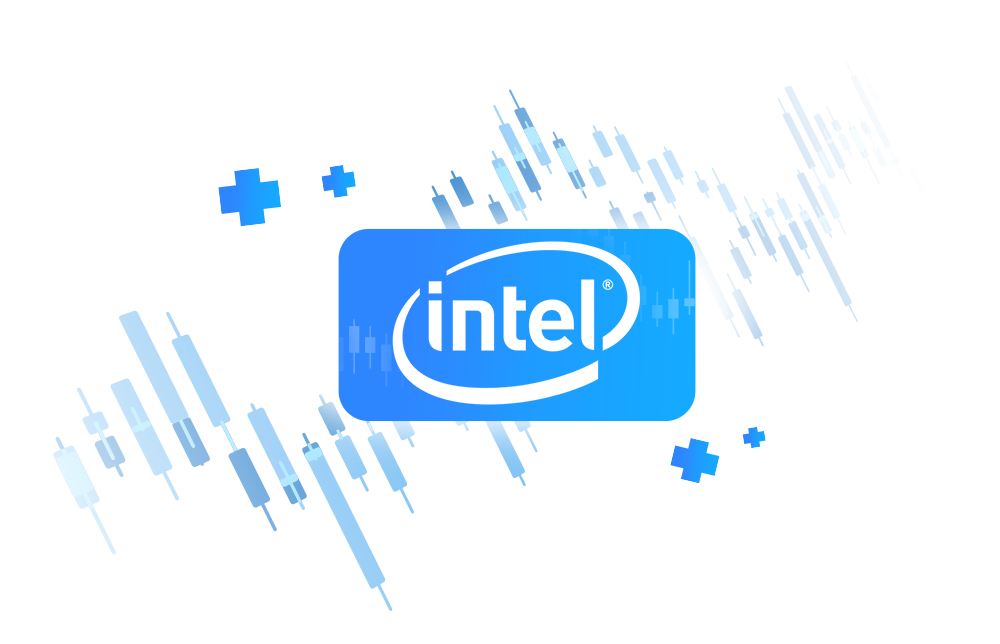Intel Corporation Share Price: What Drives INTC Stock Price?
Date Modified: 2024/10/20
Intel Corporation (INTC), a semiconductor pioneer since 1968, drives technological advancements in computing. As a leading microprocessor manufacturer, Intel's innovations impact personal and business computing worldwide.
This article examines the key factors influencing Intel's stock price, including market conditions, technological advancements, corporate governance, and competition. Understanding these factors provides insights for making informed trading decisions in the tech market.

TL;DR
- Intel Corporation, founded in 1968, is a leading American tech company.
- Intel generates revenue through diverse semiconductor products, including processors, data centres, AI solutions, and networking products.
- Technological advancements and continuous innovation boost Intel's competitive edge and drive stock price growth, while failures to innovate can negatively impact stock performance.
- CFD trading allows traders to speculate on Intel's rising and falling price movements without owning the underlying shares.
Company Overview & History
Intel Corporation was founded by Robert Noyce and Gordon Moore and is headquartered in Santa Clara, California.
Initially, Intel focused on memory chips, gaining recognition with the success of the DRAM chip in 1970 and the first commercial microprocessor, the Intel 4004, in 1971.
Over the decades, the company has maintained its innovative edge, becoming a key player in the semiconductor industry and contributing to the evolution of personal computing.
Moreover, Intel consistently uses advanced technology to produce critical computer and device components. Strategic partnerships, like the "Wintel" alliance with Microsoft, solidified its market position. The Pentium microprocessor, introduced in 1993, revolutionised personal computing by enhancing processing speeds and expanding the market for business and consumer applications.
All in all, despite competition and market fluctuations, Intel's continuous innovation and strategic initiatives have kept it relevant in the tech industry.
Key Segments Driving INTC Share Price
Intel generates revenue primarily through its diverse range of semiconductor products and services. Key segments include the Client Computing Group, which designs processors for consumer and business computers, and the Data Center and AI Group, which focuses on data centres and AI solutions. These segments contributed significantly to Intel's income, with the Client Computing Group generating over $29 billion and the Data Center and AI Group earning over $15 billion in 2023.
Intel's Network and Edge Group provides advanced networking products, contributing $5.8 billion in 2023 revenue. The Intel Foundry Services (IFS) segment produces microprocessors and partners with the US Department of Defense, generating $952 million in 2023. Furthermore, Intel focuses on innovative technologies, like AI and autonomous driving, through its Mobileye segment to diversify and strengthen its revenue streams in a competitive market.
In addition to its diverse revenue streams, various factors such as technological innovation, market dynamics, and corporate strategy play crucial roles in shaping Intel's market position and stock value.
Let's explore these key factors:
Technological Innovations
Technological innovations in the semiconductor industry, such as advancements in microprocessors and memory chips, significantly impact Intel's product performance, competitiveness, and financial health.
In 1993, despite higher profits, fears of losing technological dominance caused Intel's stock price to drop. In the mid-2000s, technical missteps let AMD gain market share, hurting Intel’s stock.
Conversely, innovations can boost stock prices by enhancing competitive edge and revenue growth. For example, in Q1 2024, Intel’s AI-enabled PCs increased client computing revenue by 31%. Continuous innovation is essential for maintaining trader confidence and stock price stability.
Market Conditions
Market conditions, including supply and demand dynamics, economic trends, and industry-specific factors, significantly influence stock prices. For semiconductor companies like Intel, these conditions are crucial for profitability and trader sentiment.
The semiconductor shortage from 2020 to 2022 illustrates how adverse market conditions can impact Intel’s stock. High demand for chips in sectors like automotive and healthcare led to production delays and revenue losses due to supply constraints. These shortages exposed supply chain vulnerabilities and created uncertainty among traders, potentially lowering stock prices.
Efforts to mitigate the shortage and boost production capacity can positively affect Intel's stock. Intel invested in new semiconductor fabrication plants (fabs), like the $20 billion facilities in Arizona, to increase capacity and balance supply and demand. These strategic moves can improve market perception, boost trader confidence, and raise stock prices.
Leadership and Strategic Decisions
Corporate governance and strategy encompass the leadership decisions and strategic initiatives that guide a company's direction. These elements are critical for Intel to maintain its competitive edge and influence stock performance.
Leadership Changes
Leadership changes can significantly impact a company's stock price as new leaders bring fresh strategies. When Pat Gelsinger became Intel’s CEO in 2021, he introduced a plan to regain the company's dominance in the semiconductor industry. This change boosted trader confidence, resulting in a 6.8% rise in Intel’s shares in 2021.
Strategic Initiatives
Strategic initiatives like Intel's IDM 2.0 strategy are crucial for market position and stock performance. Gelsinger's IDM 2.0 strategy aims to transform semiconductor manufacturing by focusing on core engineering and innovation to outpace competitors. This includes significant investments in new fabs and advanced technologies. These moves can boost market perception, trader confidence, and stock prices. Conversely, if the strategy fails or faces challenges, it could lower confidence and stock prices.
Legal and Regulatory Challenges
Legal and regulatory issues significantly impact a company's stock price by affecting financial performance and market perception. For Intel, these issues have been critical in its antitrust battles.
Intel's 1.06 billion euro ($1.2 billion) European Union (EU) antitrust fine showcases how legal challenges can hurt stock prices. The European Commission fined Intel for anti-competitive practices involving rebates to major computer manufacturers. Such fines create uncertainty and can lower trader confidence.
However, Intel's case improved when an adviser to Europe's top court found faults in the EU's analysis, suggesting key grounds of the appeal should be dismissed. Positive legal outcomes can boost trader confidence and potentially raise stock prices.
Industry Competitors
Market competition plays a crucial role in shaping a company's stock price by influencing its market share, profitability, and overall market perception. For Intel, competition from other tech giants and chip manufacturers significantly impacts its stock performance.
Intel faces intense competition from Apple (AAPL), which has increasingly moved to custom silicon since 2010, replacing Intel's processors in their products. This shift highlights how competition can negatively affect Intel’s market share and trader confidence, potentially leading to a decline in stock prices. Additionally, advancements in AI by Apple (AAPL), Advanced Micro Devices Inc. (AMD), and NVIDIA (NVDA) put pressure on Intel to innovate and keep up with industry standards.
However, competition can also drive Intel to adopt strategic initiatives, leading to potential positive impacts on its stock price. Intel’s focus on developing advanced technologies and maintaining its competitive edge in the semiconductor industry can enhance trader confidence and improve market perception.
Speculating on Intel’s Stock Price Movements: INTC CFDs
After evaluating the factors influencing Intel's stock price, one method for actively trading INTC is through contracts for difference (CFDs). CFDs enable traders to speculate on Intel's price movements without owning the actual shares, offering flexibility in both rising and falling market trends.
This approach can be particularly beneficial when reacting to significant events like technological advancements or changes in market conditions, which can drive Intel’s stock price fluctuations. However, this volatility can also expose traders to significant losses.
CFDs use leverage, allowing traders to control a larger position with a smaller amount of capital. For example, if Intel announces a breakthrough in AI technology, traders might go long on INTC CFDs, anticipating a rise in stock price.
Conversely, traders might go short if a competitor gains market share, expecting a price decline. However, while leverage can amplify potential gains, it also increases the risk of significant losses. Therefore, employing effective risk management strategies and making well-informed decisions when trading Intel CFDs is crucial.
Conclusion: Understanding Intel Corporation Stock Price Drivers
Understanding the key factors influencing Intel's stock price is crucial for making informed decisions. Technological innovations, market conditions, corporate governance, and legal and regulatory issues play significant roles in determining INTC's stock value.
Monitoring these indicators closely can offer insights into potential price movements and opportunities. Staying informed about Intel’s strategic initiatives and market position helps traders navigate the competitive landscape and make better market choices.
If you’re interested in Intel CFD trading, you can start trading INTC CFDs with Plus500.
FAQs
Intel gained recognition with the success of its DRAM chip in 1970 and the first commercial microprocessor, the Intel 4004, in 1971.
Intel generates revenue through its diverse range of semiconductor products and services, including processors for consumer and business computers, data centres, AI solutions, and advanced networking products.
Technological innovations boost Intel's stock by enhancing competitiveness and driving revenue, as seen with AI-capable processors. Conversely, failing to innovate can negatively affect stock prices.
Learn More About Intel
Related News & Market Insights
Get more from Plus500
Expand your knowledge
Learn insights through informative videos, webinars, articles, and guides with our comprehensive Trading Academy.
Explore our +Insights
Discover what’s trending in and outside of Plus500.
Stay up-to-date
Never miss a beat with the latest News & Markets Insights on major market events.


